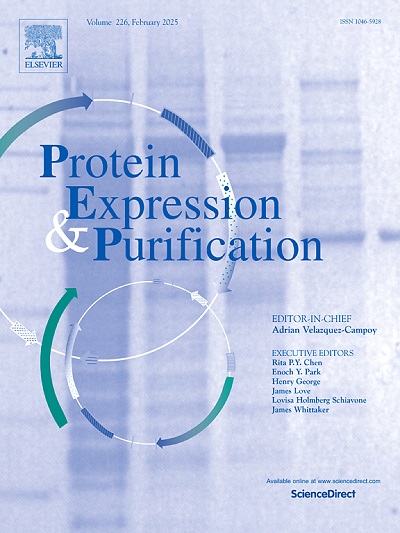Efficient production of functional proaerolysin in E. coli
IF 1.2
4区 生物学
Q4 BIOCHEMICAL RESEARCH METHODS
引用次数: 0
Abstract
Proaerolysin is a bacterial toxin produced by Aeromonas hydrophila that specifically binds to GPI-anchored proteins on the plasma membrane, forming transmembrane pores that induce cell death. Leveraging this unique property, proaerolysin is widely used in diagnostic tests for paroxysmal nocturnal hemoglobinuria (PNH), a disease caused by somatic mutations in the PIGA, a gene involved in the biosynthesis of GPI anchors. Beyond diagnostics, proaerolysin has recently been applied in basic research, including its use as a counter-selection agent in genetic manipulations and as an engineered nanopore for single-molecule detection. Although the bacterial expression and purification of proaerolysin have been previously reported, the yields were low due to its low solubility. Here, we demonstrate that using the SHuffle E. coli strain, which facilitates the disulfide bond formation in the cytoplasm, significantly improves the solubility and proper folding of proaerolysin. We achieved a high yield of proaerolysin, approximately 3 mg from a 50 mL bacterial culture, with a purity exceeding 99 %. The functionality of recombinant proaerolysin was confirmed through testing in mouse embryonic stem cells (mESCs), demonstrating that this high-yield production method provides a reliable and cost-effective source of functional proaerolysin for a wide range of biotechnological applications.
大肠杆菌中功能性原溶素的高效生产。
原气溶素是由嗜水气单胞菌产生的一种细菌毒素,它特异性地与质膜上gpi锚定的蛋白质结合,形成跨膜孔,诱导细胞死亡。利用这种独特的特性,proaerysis被广泛用于阵发性夜间血红蛋白尿(PNH)的诊断测试,PNH是由PIGA(一种参与GPI锚定生物合成的基因)的体细胞突变引起的疾病。除了诊断之外,proaerlysin最近还被应用于基础研究,包括在基因操作中用作反选择剂,以及作为单分子检测的工程纳米孔。虽然以前已经报道过细菌表达和纯化原气溶素,但由于其溶解度低,产量很低。在这里,我们证明了使用SHuffle大肠杆菌菌株,促进细胞质中二硫键的形成,显著提高原气溶素的溶解度和正确折叠。我们获得了高产量的proprolysin,大约3毫克从50毫升的细菌培养,纯度超过99%。通过小鼠胚胎干细胞(mESCs)的测试证实了重组原气溶素的功能,表明这种高产的生产方法为广泛的生物技术应用提供了可靠和经济的功能性原气溶素来源。
本文章由计算机程序翻译,如有差异,请以英文原文为准。
求助全文
约1分钟内获得全文
求助全文
来源期刊

Protein expression and purification
生物-生化研究方法
CiteScore
3.70
自引率
6.20%
发文量
120
审稿时长
32 days
期刊介绍:
Protein Expression and Purification is an international journal providing a forum for the dissemination of new information on protein expression, extraction, purification, characterization, and/or applications using conventional biochemical and/or modern molecular biological approaches and methods, which are of broad interest to the field. The journal does not typically publish repetitive examples of protein expression and purification involving standard, well-established, methods. However, exceptions might include studies on important and/or difficult to express and/or purify proteins and/or studies that include extensive protein characterization, which provide new, previously unpublished information.
 求助内容:
求助内容: 应助结果提醒方式:
应助结果提醒方式:


